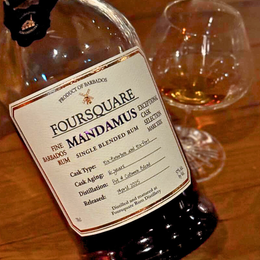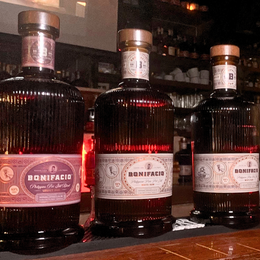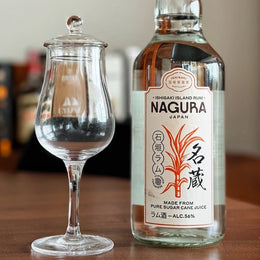
The sugar industry is one that's deeply fickle, highly alluring, and also intimately intertwined with the who, where and how of rum. There is an oft saying in the rum community that goes "where there is sugarcane, there is rum", a truism that has taken on diverse interpretations by numerous producers from all around the world.
And so today we delve into the story of an up and coming Japanese agricole-style producer, Arcabuz.


Arcabuz is named after the traditional matchlock gun brought to the island by Portuguese sailors.
Who Is Arcabuz?
The name Arcabuz may not immediately strike one as being particularly Japanese sounding, and that's not wrong - the "arcabuz" is actually a matchlock long barreled gun that was introduced to Tanegashima by Portuguese sailors centuries ago.
Arcabuz, the rum, comes from a 70-plus year old sugar manufacturer, Daito Seito, that's based in Tanegashima Island of the Kagoshima Prefecture, which itself is called the land of Shochu (a traditional Japanese spirit) and lies in southern Japan.
Daito Seito primarily operated as a sugar refiner that produced white and brown sugar, and never really had much exposure to the actual handling of the sugarcane, which they would simply procure from local growers. Yet, it's been an observation by the company for some time now, where they've seen a general trend towards declining demand for sugar as a result of folks cutting down their sugar intake as part of a more healthy lifestyle. As such the company had been actively exploring new ways in which they can turn sugar into something else - and thus the Agricole Rum project.

Daito Seito President Shigekatsu Kimura.
Getting Down And Dirty From Cane To Bottle
Yet if they were to produce rum themselves, the company, led by President Shigekatsu Kimura, knew that the quality of the sugarcane used would matter greatly. This motivated the company to begin cultivating their own sugarcane in search of the best quality cane that would translate into a great rum. As to the question of why an Agricole-style rum, Kimura had felt that it was a style that would best reflect the island's terroir. For him, there was already a great amount of molasses-based rums available, and thus the creation of one more brand was not going to stand out.
The company would thus launch the project in 2017, and would take over a 6-hectare plantation and sugar mill on Tanegashima Island - after much tussling with permits and what not, they were finally able to get started. After some research, the team concluded that two varieties of cane were to their liking - the Kurokaido and the Norin 22, both of which are local varieties. The two cane varieties are said to be rapid in gaining sucrose concentration which is necessary as it quickly deteriorates the moment the cane is cut yet is important for sufficient fermentation, and when freshly pressed also offers a melon-like taste. They've event calculated that they require something to the tune of 100 tonnes of sugarcane in order to produce 6,000 litres of rum, and that these varieties used carry half their weight in juice, which again makes them ideal.

The Tanegashima Distillery sits right next to its cane fields so that harvested cane can be freshly pressed within 24 hours of being cut.
The canes are grown in the specific area of Nakatane Town which features fertile black soil that has high water retention, with the distillery located by the seaside and the sugarcane fields spread out above it. The early days were expectedly challenging - in one particular harvest, deers had eaten up all their sugarcane seedlings and had wiped out the fields - yet the company persisted and eventually were able to harvest 290 tones of sugarcane, which gave them just slightly over what they needed.
Capturing The Terroir Of Tanegashima
As Daito Seito had wanted to be the first distillery in Japan to produce agricultural rums from cane to bottle in a single run, from the moment the cane is harvested, the team quickly brings the cane to the distillery next door, sorts and checks the cane, before then pressing it within 24 hours before the sucrose content drops. The company talks of how it is standard to press the cane three times, however for Arcabuz, only the first pressing is used as it yields the most sugar. Yeast is then added to the pressed juice which is then left to ferment for about a week, and then it's finally distilled. As Daito Seito had no prior experience in distillation, it called in the help of a rather illustrious, fast rising Kagoshima neighbour, Komasa, the company behind Kanosuke Whisky and the Mellowed Kozuru Shochu.

With a little help from a Kagoshima neighbour, Komasa.
From the stills, only the heart of the spirit is collected, with no subsequent blending involved, and no dilution as well. "We leave things as they are, as much as possible.If we do anything unnecessary, it won't taste good anymore," says Kimura. For that reason, the proof point for Arcabuz varies from lot to lot, ranging from 57-60% ABV. As for its very unique bottle shape (which it also won a Best Bottle Design Award for) - the idea here was conceived by Ken Okuyama, the first ever Japanese to design for Ferrari's automobiles, who took inspiration from the long octagonal barrel of the matchlock gun of which Arcabuz is named after - uniquely it comes with no label.
More To Come From Arcabuz
In July 2024, the first Arcabuz Rhum Blanc was finally put on sale - an expression of 7 years of ongoing effort. The unaged rum quickly picked up a Gold Medal at the World Rum Awards. But that's not all, Arcabuz is just getting started, with already rums being aged in barrel, where it hopes to debut a gold rum in 2025.

An expression of Tanegashima's terroir.
Today we're incredibly fortunate to find the debut Arcabuz Rhum Blanc at Singapore's one and only Bar Madame, a place that you can count on for bringing in some really unique and highly anticipated newly released rums from all around the world!
Let's go!
Rum Review: Arcabuz Rhum Blanc, Rhum Japonais, Tanegashima Distillery (アーキバス ラム酒 種子島蒸留所)

Tasting Notes
Colour: Clear
Aroma: Remarkably aromatic, great intensity and yet keeps a rounded and plush bouquet. Vanilla tones, banana blossoms, cane syrup, some crushed cane vinasse. It's fresh and light without being high toned, with also this lifted quality. There's alittle bit of sourdough batter as well. It levels to a richness and mellowness that's filled in with all these bounties of florals.
Taste: More on those bright and fresh delicate banana blossom, banana bunches, vanilla cream. It's delivered rather punchily and with quite a bit of intensity - cracks of black pepper. That heat tempers the rich and rounded sweetness. Into the finish, some savouriness makes an appearance too.
Finish: Gentle notes of cane syrup, a persistence of those banana blossoms, with also a return of that cane vinasse. It's a long and deep finish, clean with a prolonged savouriness.

My Thoughts
This was a pretty solid white rum - it's got a very classic profile, where here I find that it expresses more of a floral aspect to it. It's also surprisingly rich and plush whilst keeping that lifted and bright freshness of banana blossoms. It has this archetypal tropical island quality to it, without itself being overly potent, overwhelming or one dimensional. This makes a great Daiquiri.
Kanpai!

@111hotpot







